Agriculture
Houzan’s sweet potatoes, the foundation for deliciousness
Making sweet potato shochu begins in the fields. This is a belief that forms the foundation for Houzan’s deliciousness.
We exclusively use sweet potatoes grown in Kagoshima Prefecture by our contracted farmers.
These farmers do more than just simply grow our sweet potatoes.
They actively suggest different varieties to enhance the quality of our shochu.
Our “Josen” series is a product of such collaborative efforts.
The sweet potatoes, sourced from these essential partners, arrive at our distillery every morning. All our employees participate in sorting and processing them while they are still fresh, ensuring the quality of our shochu.


The uniqueness of Kagoshima sweet potatoes
-
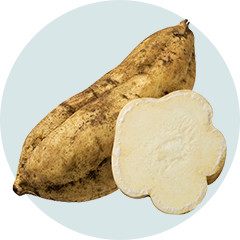
Koganesengan Named for their pale golden (kogane) appearance and high yield of 8,267 pounds (sengan) per 1,200 square yards, these delicious sweet potatoes are rich in starch.
It is widely used as the principal ingredient in imo shochu production, known for its rich and flavorful characteristics. -
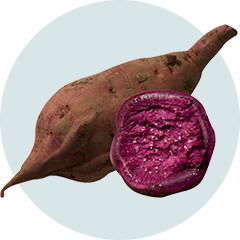
Ayamurasaki This purple sweet potato is rich in anthocyanins, a type of polyphenol.
While it has a lower starch content, requiring more effort to ferment, it is distinguished by its splendid sweet aroma and a flavor reminiscent of wine. -
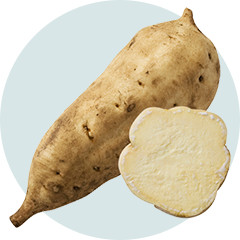
Shiroyutaka This variety is in starch and is distinguished by its sweet, well-rounded flavor.
True to its name, which implies 'white abundance,' Shiroyutaka has a white flesh.
When cooked, its texture is similar to that of Koganesengan. -
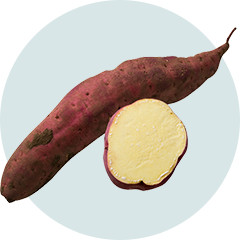
Beniazuma Famed for its fluffy and powdery texture when steamed, this sweet potato is delightfully sweet and delicious.
It's an early-maturing variety that has a short cultivation period, and its flavor is particularly excellent when freshly harvested.
-
Cultivating flavors for decades to come at our experimental farm.
At Nishi Shuzo’s experimental farm, a part of our “kura without a roof”, we explore the potential of sweet potatoes to create novel shochu flavors.
We are currently cultivating 34 varieties, but the possibilities are vast and uncountable.
There is still so much potential to be uncovered.
Of course, not all experiments go as planned.
The fruition of these endeavors may take decades, even centuries.
However, in the realm of agriculture and shochu making, deeply rooted in human history, true value emerges through generational continuity.
Our quest transcends time and continue across generations.
For the entire year,
we use only rice grown in Kagoshima Prefecture
We use only local rice cultivated with care by our farmers in Kagoshima Prefecture. During the harvest, we stockpile a year’s supply of this brown rice. Our rice storehouse, capable of holding up to 1,100 tons, maintains a constant temperature of 13℃to 15℃ to preserve the rice’s freshness.
Every day, each batch used in our shochu production is brought to room temperature and rested for a day before being polished and prepared as koji rice.
Such practices might be unconventional for a shochu distillery, but our commitment to 100% locally sourced ingredients is a testament to our philosophy and an extension of what we see as a natural choice.
At Nishi Shuzo, our reverence for agriculture - the very cradle of exquisite flavors - remains unwavering. We are dedicated to enriching the unique taste profiles that can only emerge from the hands of those who walk the lands of Satsuma.


Why a shochu distillery built a rice storehouse
Next to Nishi Shuzo’s shochu distillery is our rice storehouse, where we keep our koji rice.
It’s a juxtaposition that can’t be seen at most other places, and people often wonder why we went this far.
It’s due to our desire to do whatever it takes to deliver the best sweet potato shochu in Japan.
The basis of imo shochu’s delicious flavor comes from the earth. The distinctive character of Nishi Shuzo’s character can only be born from the agriculture of the countryside which surrounds us.
This rice storehouse is the manifestation of our commitment to making shochu that starts with the land.


Koji, the lifeblood of shochu
-
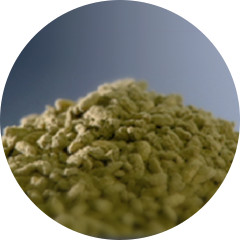
Ki/Yellow kojii Producing less acid to suppress the growth of unwanted bacteria, a high degree of skill and precise management is required for its production.
-
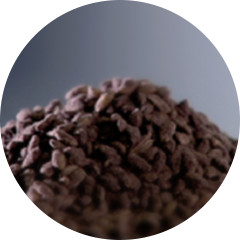
Kuro/Black koji Able to generate citric acid, which is effect in prevention the fermentation mash from spoiling.
-
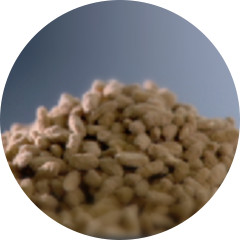
Shiro/White koji A natural mutation of black koji and used for many types of shochu.
Similar to black koji in its production of acid. -
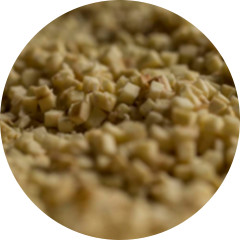
Imo/sweet potato koji Harder to propagate than on rice and requiring delicate temperature control.
The preparation takes time and effort, but the umami and superb aroma of sweet potatoes stand out.
-
Agricultural Product Inspectors
Nationally certified Agricultural Product Inspectors are qualified to determine the quality and safety of agricultural products, especially rice.
Two of Nishi Shuzo’s team members hold this certification, amongst only about 20,000 people in the country.
Of course, one of our goals is to standardize the quality of our koji rice, which is a key to the shochu’s quality, but it is also connected to our commitment to making shochu that starts with the land.
We strive to be professionals at every stage of the process until the shochu is finished.
Therefore, Agricultural Product Inspectors are an indispensable root that grounds Nishi Shuzo to the earth.
No distillery in a place without good water
The rains that fall from the skies of Satsuma seep slowly into the earth, eventually collecting as groundwater 300m below the surface, traveling at only a rate of 1m per year.
The underground water that spurts from the bedrock has the perfect mineral content for making shochu.
As we make our shochu every day, we are thankful for the water of Kagoshima that the nature of Fukiage has blessed us with.


